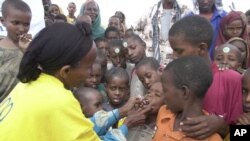Nations could greatly improve their development prospects by investing in their young, this year’s State of the World Population report argues. Conversely, it says countries that dismiss their young as unimportant do so at their peril.
The UNFPA report, released Tuesday, contends countries will reap immense benefits – a so-called "demographic dividend" – if they invest heavily in young peoples’ education, skills and health, including sexual and reproductive health.
Young people matter because they are so numerous, the report says: An unprecedented 1.8 billion people between the ages of 10 and 24 can lift hundreds of millions of people out of poverty if governments provide them with opportunities and jobs to develop their capabilities.
This is not a theoretical concept, said Alanna Armitage, who directs UNFPA’s office in Geneva. In the 1960s, several East Asian countries invested heavily in young people, she said, noting that many young people who had access to family planning started their families at an older age and had fewer children.
Benefits to GDP
She said these investments in the young achieved huge dividends. They contributed to a 6 percent surge in gross domestic product and the quadrupling of per capita incomes in some countries.
"If sub-Saharan Africa drew on East Asia’s experience, adapted it to its local context and made comparable investments in young people, the region could experience an economic miracle of its own, adding as much as $500 billion to its economies every year for as many as 30 years," Armitage predicted.
Unfortunately, she said, too few governments are making the necessary investments in young people that would secure their future and that of their societies.
Today, nine out of 10 young people live in less-developed countries where they encounter obstacles to education, health care and violence-free lives, Armitage said.
Barriers to jobs
They also find impediments to employment.
"An estimated 120 million young people enter the labor force every year," she continued. "The UNFPA report shows that young people already account for two in five of the world’s unemployed.
"On the road to realizing their potential, more and more young people today are running up against a wall of inequality, discrimination and exclusion – and we know that young women and adolescent girls face more obstacles than young men and boys in building their capabilities, seizing opportunities and enjoying their rights."
The report presents a number of concrete recommendations for increasing investment in enhancing young people’s skills and knowledge. It calls for expanding access to contraception, creating more employment opportunities and increasing possibilities for young people to use new technologies.










